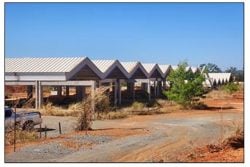One of the things that the release to the public of the results of the major examinations in our primary and secondary schools systems usually does is to present what one might call ‘the bright side’ of an education system.
When the vicissitudes of the Covid-19 pandemic are added to the much more protracted challenges that our education system has had to face, the performances of our children at these examinations provide every reason for celebration.
Just about two months following the destruction of the St. George’s High School by fire, a circumstance that created an immediate emergency in the matter of the continuity of education delivery to a reported 400-odd students, we are being told that the Ministry of Education has put in place what Guyanese commonly refer to as a ‘doubling up’ arrangement in some schools in order to allow the displaced students to be accommodated in alternative schools so that there is no break in the delivery of their education.
‘Doubling up,’ in our circumstances, has become commonplace, there being no other feasible option when state schools are rendered ‘out of commission’ mostly on account of fires that either completely destroy the schools or damage them sufficiently to result in the need for considerable and time-consuming repairs. One imagines that what can also be termed ‘stop gap’ pursuits, insofar as these are far from ideal options, are bound to impact on the normal regimes at the host schools though there exists no reliable channel through which we can properly determine the extent of the impact which those interventions have on the overall quality of education delivery at the host schools.
We may, for example, know little of the extent to which they are able to comfortably ‘make room’ for their displaced colleagues since they might well have already been facing their pre-existing limitations including ‘teacher pressures.’ In our circumstances, such makeshift arrangements will unfailingly pose their own challenges, often imposing ones, as much for the displaced children as for the populations of the host schools. Of course, the extent of the challenge for the host schools as much as for their guests will vary in degree from one instance to another.
What must also be said – and the North Ruimveldt Multilateral School is a good example of this – is that the conditions that confront both the displaced children and the schools that must temporarily absorb them are rendered no less bearable by the fact that it does not appear that the restoration of affected schools to conditions of repair are usually pursued by the authorities with anything even remotely resembling maximum alacrity. Surely, in circumstances of such evident emergency, there has to be some ’fast track’ mechanism that is both transparent and expeditious for ensuring that affected schools are restored and returned to service in the shortest possible time. This is not usually the case.
The restoration of schools that are rendered unusable (by fires or otherwise) is not a matter that is ventilated in the public space every day, though when one comes to think about it – and given the various other pre-existing deficiencies in our education system – there is every reason to expedite the restoration of the affected schools since the burden which the ‘doubling up’ option imposes upon the schools, both the incumbents and the displaced children, can and does, eventually, sooner or later, become onerous.
One might have thought that if it had been felt that providing reassurance regarding the expeditious restoration of St. George’s High School almost two months after it was completely destroyed by fire was the thing to do, then the authorities would have, by now and at the very least, sought to completely remove the unsightly rubble left by the fire. This, even if, as we understand it, there are uncertainties surrounding whether or not a new school will be built on the present site.
No information in this regard has been forthcoming. Setting aside the dispersal of the affected children to schools elsewhere, including in Region Three (here one imagines that questions of transportation costs for the parents arise) there are other issues that are going to have to be addressed including those that have to do with aspects of the sustainability of the prevailing makeshift arrangements.
As an aside, the proffering of the reason of electrical faults for fires that recently levelled two large urban state-run schools, creating significant dislocation in our education delivery system within a period of less than a year, raises the questions (and these are by no means new questions) regarding the far less than warranted attention that government, over the years, has paid to the maintenance of ‘good infrastructural order’ at state schools. Truth be told, the evidence that obtains at some state-run schools suggest that there is a considerable lack of official mindfulness in matters pertaining to things like the safety and reliability of electrical systems and some of the other wider infrastructural considerations that attend the security of those schools. Contextually, it may well be that in the instances of both the North Ruimveldt and St. George’s Secondary schools, the conflagrations might have been avoidable.
Insofar as the affected schools are concerned the question also arises as to whether the makeshift arrangements put in place when emergencies like fires occur are not allowed to persist for far too long, providing comfort zones that distract from the importance of tackling substantive remedial efforts with the requisite alacrity. In the instance of the North Ruimveldt Multilateral School it has already been a year…and counting.
In the instance of St. George’s the seeming official indifference to the removal of the unsightly rubble left in the wake of the fire that destroyed the school almost two months ago is far from reassuring. If anything, what it does is to dampen hopes that there are plans to rebuild the school in a hurry, if at all.
One might argue, from a mathematical standpoint, that while the addition of a few dozens of displaced St. George’s children to classes in temporary ‘host schools’ ought not to make a huge logistical difference, those directly responsible for the education delivery regime in that altered environment can contend with considerable justification that ‘randomly’ (perhaps even arbitrarily) fitting in handfuls of displaced St. George’s children into different schools does not, by any stretch of the imagination, contribute to what one might call a convivial learning environment.




